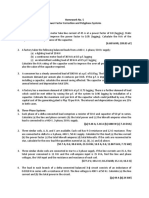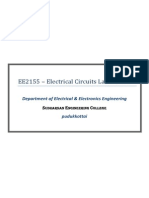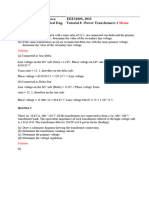Light Intensity Control
Uploaded by
Raman GargCopyright:
Available Formats
Light Intensity Control
Uploaded by
Raman GargCopyright
Available Formats
Share this document
Did you find this document useful?
Is this content inappropriate?
Copyright:
Available Formats
Light Intensity Control
Uploaded by
Raman GargCopyright:
Available Formats
DYANMIC RESPONSE:-
In the earlier section it was maintained that the process of lighting a bulb resulting resistance changes of the LDR were almost instantaneous and hence the whole system was non dynamic.this resulted in a greatly simplified analysis .despite the presence of non linear elements in the system.strictly speaking
however the filament of the lamp has a small but non zero thermal capacitance and therefore needs a little time to heat up and stsrt glowing .this result ina single time constnt in the system while it is still possible to neglect the LDR response time.
ERROR DETECTOR
COMMAND
CONTROLLER
PROCESSS
OUTPUT
TRANSDUCER
EXPERIMENT :- to study the light intensity control system in open loop and closed loop and find out
a. b. c. d.
identification of the non linear characteristics Effect of P& PI on error signal Disturbance rejection using p &PI controller Dynamic response of controller circuit (P & PI)
Procedure The following subsection outline the different experiments designed on the set up 4.1 characteristics of the non-linearitys
1.2 1 sensor voltage,VF 0.8 0.6 Series 1 0.4 0.2 0 0 1 2 3 number of lamps,n 4 5 6
GRAPH 1
Study of a system usually begins with an analysis of its sub system. The characterization of the non linear sections of the system is therefore very important 1. Set up the system in open loop with VR =0 and K=0 2. Switch ON the disturbance lamps one by one and read VF 3. Now all the disturbances lamps are switched OFF and set the VF at the last reading by adjusting VR and K 4. Now again ON the disturbance lamp one by one and take next three readings for VF 5. Tabulate the readings as shown below and plot VF VS. n, the number of lamps switched ON fig 5(a) shows the non- linear characteristics of the LDR sensor i.e. F2 (VF=f2.n). 6. Switch OFF the disturbance lamps, continue operation in the open loop.
7. Adjust VR and K to vary VL in small steps and records VF in each case. 8. Also obtain and record at each step the effective vale of n from fig. (a). tabulate the data as below. 9. Plot graph as in fig (b), between n and VL to depict the non-linear characteristics of the lamps, i.e., F1(n=F1V1). 10. Plot graph as in fig. 5(c) between VF and VL to depict the loop non-linearity, i.e., F1F2. [VF=F1F2VL] ERROR WITH P PI CONTROL In this experiment the purpose is to study how the error varies as a function of forward gain K. also at each step the improvement achieved by PI control is observed. The steps for the experiment are given below: 1. Connect the system in closed loop. Switch off all the disturbance lamps. put p/pi switch to p position 2. Set VR =0.5 V for various settings of K=5,10,20. Record the values of VE<VL<VF 3. For each reading calculate and record. Compare the measured and computed value of error VE 4. Further, at each reading put the P/PI switch to position and observe how the error voltage,VE, decreases .record this VE and vswitch back to P-control for the next readings .tabulate the readings as shown in table(3). DISTURBANCE REJECTION This experiment is designed to study the disturbance rejection properties of negative feedback as a function of the forward gain. The various steps for this experiment are: Operate the system in close loop with all disturbance lamps switched off
5. Set k to 10.adjust VR to get VF=0.5 6. Switch on the disturbance lamps one by one and at each step record the value of VF 7. Calculate further the percentage increase in intensity (i.e VF ) every time a disturbance lamp is switched on
Set K=40.adjust VR to get VF =0.5 repeat the above steps. Repeat with K =70 .tabulate the readings as shown in table 4 DYNAMIC RESPONSE
This experiment is aimed at observing the time taken by the lamp filaments to heat up and cool down whwn a square wave command signal is superimposed on the normal reference or command VR .the important thing to observe here is that the basic nature of the response is dependent on the operating point or the value of VR this phenomena is due to non linearity in the system and will not be observed in a linear system.the steps for conducting this part are, 1. Coneect the system in closed closed loop. Switch off all the disturbance lamps 2. Set VR+0.5.k=5 and connect the squre wave source to the error detector.the controlled lamps will flicker which can be seen by opening the lamp cover. 3. Operate a double beam CRO in the X-Y mode.connect the X-Y and ground terminals on the panel.observe the waveform on the screen. 4. Vary VR and comment on the results
You might also like
- Ell100 Lab Report: Single Phase Transformer B-H LoopNo ratings yetEll100 Lab Report: Single Phase Transformer B-H Loop10 pages
- Polyphase Ac Circuit Short Questions With AnswerNo ratings yetPolyphase Ac Circuit Short Questions With Answer3 pages
- Triangular Wave Generator Using Op Amp - WaveformsNo ratings yetTriangular Wave Generator Using Op Amp - Waveforms6 pages
- Experiment No. 3: Characteristics of CMOS InverterNo ratings yetExperiment No. 3: Characteristics of CMOS Inverter6 pages
- "Bridge B2HZ" For The Control of A DC MotorNo ratings yet"Bridge B2HZ" For The Control of A DC Motor16 pages
- Name: Date:: Experiment 02 Common Base Amplifier67% (3)Name: Date:: Experiment 02 Common Base Amplifier3 pages
- AVG and RMS Values of Periodic Waveforms 2012No ratings yetAVG and RMS Values of Periodic Waveforms 20125 pages
- Cha:3 Special Instruments: Power Factor Meter Frequency Meter Synchroscope Phase Sequence IndicatorNo ratings yetCha:3 Special Instruments: Power Factor Meter Frequency Meter Synchroscope Phase Sequence Indicator25 pages
- Experiment 2 (LOW PASS FILTER USING OP-AMP)No ratings yetExperiment 2 (LOW PASS FILTER USING OP-AMP)5 pages
- Non-Linear Wave Shaping Circuits Clippers AIMNo ratings yetNon-Linear Wave Shaping Circuits Clippers AIM5 pages
- 2 Experiment PSPICE RC RL and RLC SimulationNo ratings yet2 Experiment PSPICE RC RL and RLC Simulation5 pages
- Capítulo 1 Basic Concepts - em - InglêsNo ratings yetCapítulo 1 Basic Concepts - em - Inglês49 pages
- Measurement of Reactive Power of Star and Delta Connected Balanced Loads0% (1)Measurement of Reactive Power of Star and Delta Connected Balanced Loads3 pages
- Aim: To Test Differentiator and Integrator Circuits Using Ua741op-Amp100% (2)Aim: To Test Differentiator and Integrator Circuits Using Ua741op-Amp8 pages
- Magnetic Amplifier in Series: Operation ManualNo ratings yetMagnetic Amplifier in Series: Operation Manual6 pages
- Experiment 5 Separately Excited DC Generator Speed Characteristics100% (1)Experiment 5 Separately Excited DC Generator Speed Characteristics5 pages
- Study and Analysis of Double-Line-To-Ground FaultNo ratings yetStudy and Analysis of Double-Line-To-Ground Fault5 pages
- Mechanical Power Developed by A Synchronous MotorNo ratings yetMechanical Power Developed by A Synchronous Motor3 pages
- Hydrodynamic Cavitation Review Paper Wang2021No ratings yetHydrodynamic Cavitation Review Paper Wang202129 pages
- Metallic Implant Materials: 5.1. Stainless SteelsNo ratings yetMetallic Implant Materials: 5.1. Stainless Steels36 pages
- Microfabrication Lab Georgia Tech 2011: David Gottfried Mikkel Thomas Paul Joseph Greg Book Janet Cobb-SullivanNo ratings yetMicrofabrication Lab Georgia Tech 2011: David Gottfried Mikkel Thomas Paul Joseph Greg Book Janet Cobb-Sullivan40 pages
- Design Recommendation For Screw Machine ProductsNo ratings yetDesign Recommendation For Screw Machine Products23 pages
- Plants-Hormones-Responses-And-Feedback-Mechanisms Gen Bio Week 3No ratings yetPlants-Hormones-Responses-And-Feedback-Mechanisms Gen Bio Week 314 pages
- Mathematical Analysis of Recursive AlgorithmsNo ratings yetMathematical Analysis of Recursive Algorithms19 pages
- 5.2 Work Done & Energy Transfer: Question PaperNo ratings yet5.2 Work Done & Energy Transfer: Question Paper5 pages
- Cellulose Nanowhiskers: Promising Materials For Advanced ApplicationsNo ratings yetCellulose Nanowhiskers: Promising Materials For Advanced Applications13 pages
- Identification of Schools Adjacent To The Kalihi To Ala Moana Impact Fee DistrictNo ratings yetIdentification of Schools Adjacent To The Kalihi To Ala Moana Impact Fee District1 page
- Edlén - 1966 - The Refractive Index of AirNo ratings yetEdlén - 1966 - The Refractive Index of Air11 pages
- Statistical Quality Control and Reliability EngineeringNo ratings yetStatistical Quality Control and Reliability Engineering2 pages
- Ell100 Lab Report: Single Phase Transformer B-H LoopEll100 Lab Report: Single Phase Transformer B-H Loop
- Triangular Wave Generator Using Op Amp - WaveformsTriangular Wave Generator Using Op Amp - Waveforms
- Experiment No. 3: Characteristics of CMOS InverterExperiment No. 3: Characteristics of CMOS Inverter
- Cha:3 Special Instruments: Power Factor Meter Frequency Meter Synchroscope Phase Sequence IndicatorCha:3 Special Instruments: Power Factor Meter Frequency Meter Synchroscope Phase Sequence Indicator
- Measurement of Reactive Power of Star and Delta Connected Balanced LoadsMeasurement of Reactive Power of Star and Delta Connected Balanced Loads
- Aim: To Test Differentiator and Integrator Circuits Using Ua741op-AmpAim: To Test Differentiator and Integrator Circuits Using Ua741op-Amp
- Experiment 5 Separately Excited DC Generator Speed CharacteristicsExperiment 5 Separately Excited DC Generator Speed Characteristics
- Power System Wide-area Stability Analysis and ControlFrom EverandPower System Wide-area Stability Analysis and Control
- Microfabrication Lab Georgia Tech 2011: David Gottfried Mikkel Thomas Paul Joseph Greg Book Janet Cobb-SullivanMicrofabrication Lab Georgia Tech 2011: David Gottfried Mikkel Thomas Paul Joseph Greg Book Janet Cobb-Sullivan
- Plants-Hormones-Responses-And-Feedback-Mechanisms Gen Bio Week 3Plants-Hormones-Responses-And-Feedback-Mechanisms Gen Bio Week 3
- Cellulose Nanowhiskers: Promising Materials For Advanced ApplicationsCellulose Nanowhiskers: Promising Materials For Advanced Applications
- Identification of Schools Adjacent To The Kalihi To Ala Moana Impact Fee DistrictIdentification of Schools Adjacent To The Kalihi To Ala Moana Impact Fee District
- Statistical Quality Control and Reliability EngineeringStatistical Quality Control and Reliability Engineering

























































































